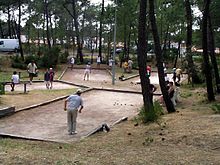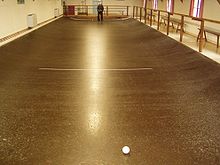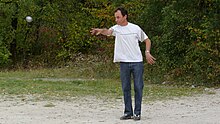Petanque game
In a narrower sense, is the term (from French la boule “the ball”) or boule game only briefly for the ball sport Boule Lyonnaise , the so-called “sport boule”.
In Germany, however, “Boule” (like the word “Boccia”) is used more colloquially as a collective term for all ball sports , as is the case in this article. In addition to the aforementioned Boule Lyonnaise, the ball sports also include the Jeu Provençal derived from it , its offshoot of pétanque , British bowls and Italian boccia (also known as "Raffa"). In addition to these five "official" ball sports, there are other regional sports or ball games that have similar rules, such as: B. Boule-en-Bois, Boule-de-Fort, Boule-des-Berges and Boule bretonne .
Many Germans also associate “boules” with the recreational ball game played by the French in public places. The correct name for this, however, is pétanque. With around 600,000 license players in 76 (national) pétanque associations, it is the most widespread ball sport.


history
As early as 460 BC Christ is a recommendation of Greek doctors (including Hippocrates ) for playing with stone balls. In the 2nd century AD, Iulius Pollux described a game in which balls were thrown at a brick; the loser of the game had to carry the winner to the finish line on his shoulders. Boccia and Boule Lyonnaise have their common roots in this game that was widespread in the Roman Empire. The roots of bowls can be traced back to London in the 12th and 13th centuries. Century.
From the Middle Ages, boules in France can be proven primarily through its prohibitions:
- In 1319 Philip V prohibited the game of boules
- In the 14th century, the Archbishop of Tournay prohibited the game of boules (in the French department of Hautes-Pyrénées )
- 1629 there was a ban by the French parliament to the badminton promote
- In 1697 the diocesan synod in Paris banned clergy "... playing boules in public or in the presence of secular people"
- on the other hand, the decree of the Lyon police not to play on the roads connecting the towns and not on the main streets of the city has a purely regulatory character
- In 1900, boule was one of the sports that were held in the French capital Paris on the occasion of the World Exhibition ( Exposition Universelle et Internationale de Paris ) held international competitions for physical exercise and sport (Concours Internationaux d'Exercices Physiques et de Sports) . Several of these competitions were part of the 1900 Olympic Games . However, the International Olympic Committee (IOC) had refused to officially recognize boules as an Olympic sport .
- In 1907 the first pétanque game was played in the French port city of La Ciotat (see: → Pétanque: History ).
Organizations
The international umbrella organization for the boules sports pétanque, Jeu Provençal, Boule Lyonnaise, boccia and bowls is the Confédération Mondiale des Sports de Boules (CMSB).
In Germany there is the German Pétanque Association (DPV), the Boccia Bund Deutschland (BBD) and the German Boule Association Section Lyonnaise (DBLV), which have merged to form the umbrella organization of the German Boccia, Boule and Pétanque Association .
In Austria , pétanque and boccia are played organized within the framework of the Austrian Pétanque Association .
In Switzerland, pétanque (Fédération Suisse de Pétanque), Boule Lyonnaise (Fédération Suisse de Boules) and boccia are organized.
Disambiguation
Delimitation "ball" - "ball"
Originating from the English-speaking sports like bowling and snooker use the word for their ball-round sports equipment ball (dt .: Ball, ball ), although the use of the words is not uniform in the rules to some extent.
"Kugelsport"
Ball sports in the narrower sense are the sports organized in the Confédération Mondiale des Sports de Boules (CMSB). Quote: "The CMSB was recognized by the IOC (Comité International Olympique) on October 15, 1986 in Lausanne as a representative of all ball sports." (For details see below under: Organizations )
In France at least there are some regional ball sports organized in associations, the rules of which are very similar to the basic rules of the game (see below) of the CMSB sports. These are also covered here.
Sports such as curling and stick sports are tactical and similar to ball sports.
There are also ball sports, especially in the traditional and leisure areas. If they are similar to the CMSB sports in the playground, they are also dealt with here. Other ball sports are more of a long throw discipline (e.g. Boßeln ).
Bowling is a sport of skittles , snooker is not a sport of billiards . The shot put is part of athletics .
Delimitation leisure game - sport
Boccia and boules are the most popular leisure options in Germany.
Boccia
Boccia became particularly popular in Germany thanks to the former Chancellor Konrad Adenauer , who was shown in newsreels while playing boccia while on vacation in Italy . In the period that followed, a recreational game with water-filled plastic balls came on the market, which has little in common with the actual boccia game (Punto-Raffa-Volo).
Boules
Many Germans associate boules with the recreational ball game played by the French in public places. However, the correct name is pétanque . The French use pétanque to distinguish it from other French boule (ball) sports.
The game in public places is the leisure variant, the sport variant is played on or in club facilities (boules pitch (French: Boulodrome ) or boules halls).
One type of boule is crossboule , in which the venue is not fixed, but moves dynamically in the general public space (similar to a variant of Boßeln ).
In Germany, the leisure variant was "imported" mainly by tourists in France and was mostly called boules. In the rules of the game, recreational players follow the pétanque rules.
The sport of pétanque was initially practiced in Germany near the French border and / or in the French occupation zones . So z. B. in Berlin in the former French settlement at Tegel Airport a boulodrome created by the French, which after the departure of the French from the Club Bouliste de Berlin e. V. was bought up.
Basic rules
In all of the sports mentioned, two teams or formations consisting of one to three players play against each other. The possible team strengths are different in the individual sports.
The aim is to get as close as possible to a target ball with your own balls. The target ball and the opposing balls can also be pushed out or shot away. In France the target ball is called cochonnet (German: piggy ).
Sometimes it's just a matter of shooting as precisely as possible. For this, there is precision shooting, a kind of special shooting competition, in pétanque and boule Lyonnaise.
Competition balls
The following table shows the dimensions and materials of the competition balls.
| Sport and ball style | material | Weight [grams] | Diameter [mm] | particularities |
|---|---|---|---|---|
| Balls in the boules sports | ||||
|
Boule Lyonnaise game ball target ball |
Metal wood |
900–1400 --- |
90-110 25-35 |
--- |
|
Boule-en-Bois game ball target ball |
Wood wood |
1500 --- |
100-130 55 |
Hole for thumb --- |
|
Boule-de-Fort game ball target ball |
Wood with plastic steel jacket |
1300–1400 --- |
125 80 |
asymmetrical --- |
|
Boule-des-Berges game ball target ball |
Metal steel |
1000–1100 --- |
100 > 50 |
--- |
|
Jeu Provençal game ball target ball |
Metal wood |
650–800 --- |
70.5-80 25-35 |
--- |
|
Pétanque game ball target ball |
Metal wood, plastic |
650–800 --- |
70.5-80 29-31 |
--- |
|
Boccia game ball target ball |
Wood / plastic PVC |
920–1000 --- |
107-113 39-41 |
--- |
|
Bowls game ball target ball |
Wood wood |
1570 --- |
135 25-35 |
flattened on one side --- |
| For comparison “balls” in non-boule sports | ||||
|
Billiards cone billiards [a] carom [a] pool billiards Russian billiards snooker [b] |
Phenolic resin formerly: ivory |
194-220 205-220 179 200-284 142 ± 0.3 |
60.3 ± 0.5 61.5 ± 0.1 57.2 78 52.5 ± 0.05 |
--- |
| Bowling [a] | Plastic shell coverstock filling material |
2724-7264 | 218.3 | with 3 holes for fingers |
| Bowling | homogeneous plastic mass |
2818-2871 | 160 ± 0.5 | --- |
- [a] the term "ball" is only used colloquially, the rules of the respective sport use the term " ball "
- [b] Name unclear, colloquially called "ball" or "ball", in the material standards of the rules of the German Billiard Union , "balls" is used.
Explosion Risks
In 2009 a bullet exploded in Switzerland. Subsequent investigations by EMPA found that the balls sold by Coop were filled with mortar in order to save metal for the shell. The filling corroded the metal and formed an explosive gas mixture.
In September 2016 another bullet exploded at a neighborhood festival in Nettetal . As a result, the remaining bullets were blown up in a controlled manner by the emergency services. The boules and pétanque association in North Rhine-Westphalia then advised looking for quality marks when buying balls. Tested balls would show the company name, a serial number and the weight.
Forms of competition
There are different forms of competition:
- Tournaments and championships in formations
- Tournaments, league competitions and championships with teams
- Competitions and championships in precision shooting
Teams and formations
A team consists of several formations.
Boccia
In boccia there are formations
- Individuals
- Coppia (double)
- Terna (threesome)
Boule Lyonnaise
The following formations exist at Boule Lyonnaise
- Simple (single)
- Double
- Triplet (team of three)
- Quadrette (team of four)
Bowls
The following formations are played in bowls
- Singles game (singles)
- Pairs game (doubles)
- Triples game (team of three)
- Fours game (team of four)
Similar to tennis, bowls are predominantly played singles. There are also side games, series of singles games, team games or side games and tournament forms (tournament of games)
Jeu Provençal
Jeu Provençal is mainly played as a triplet (3 players), there are also the formations Doublette (2 players) and Tête à tête (1 player)
Petanque
The following formations are played in pétanque :
- Tête à tête (German: "head to head", single)
- Doublet (Double)
- Triplet (threesome)
From the doublette onwards, a distinction is made between the pointeur (the “leger”) and the shooter (the “shooter”, French tir “shot”), in the triplet there is also the milieu (French for “middle”).
In Germany, national and German championships in Tête-à-Tête are held. Internationally, triplets are usually played. In contrast to bowls, where mostly singles are played, there are fewer tournaments for individual formation in pétanque.
In addition, international and national tournaments as well as championships for teams composed of several formations are organized. There are different rules about the formations belonging to a team.
- Main article: Petanque competitions
Precision shooting
In pétanque and boule Lyonnaise there is precision shooting.
The Lyonnaise disciplines Tir progresif and Tir de précision are on the program at the World Games and the Mediterranean Games .
In pétanque there are world championships , European championships and German championships in the tir de précision .
Regional sports
Boule-en-Bois
Boule-en-Bois (also Boule de bois or La Vendéenne) is a ball game that in Belgium in the regions of Chimay , Momignies , Sivry-Rance and Couvin , as well as four small towns in Sud-Hainaut and Sud-Namurois is played .
Boule-de-Fort

Boule de fort is a traditional ball game in Anjou and Touraine .
There are the following special features: asymmetrical balls and a kind of channel as a track that is 20 meters long and 7 meters wide. See also Boulodrome .
Boules of the mountain
The rules of Boule des Berges (also: Boule parisienne) were developed around 1865. Boule des Berg was an unofficial Olympic sport in 1900 .
Boule bretonne
Boule bretonne is a popular sport in Brittany , related to Boule Lyonnaise and Pétanque .
Similar sports
The aim of the game is similar to that of boules in the following sports, albeit with different sports equipment:
- Bootschen
- Curling
- Shuffleboard
- Ball hitting
- Stock shooting (ice stock sport or stock sport)
- Jeu de palets
- Tagus river
- Crossboule
When Boßeln balls are thrown far.
See also
Individual evidence
- ↑ see: " Timeline for the history of the ball games ( Memento from October 9, 2007 in the Internet Archive )"
- ↑ Quote from article on the DPV website
- ↑ see: Chronicle on the website of Club Bouliste de Berlin e. V. ( Memento from August 27, 2013 in the Internet Archive )
- ↑ The physical material properties of natural ivory cannot be fully achieved by plastics
- ↑ Boule ball explodes in Nettetal. (Not available online.) In: WDR.de . WDR , September 5, 2016, archived from the original on July 31, 2017 ; accessed on July 31, 2017 .
Source: DPV website GFDL approval: Ticket #: 2006111710003577



